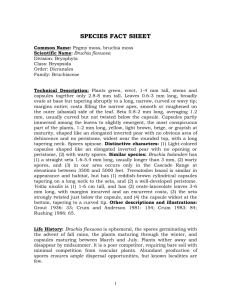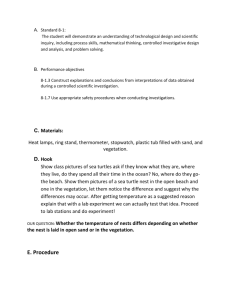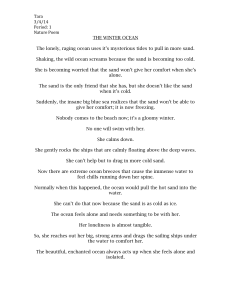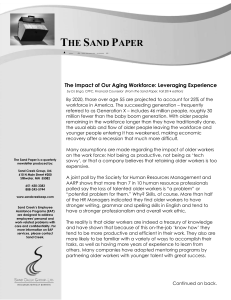emi412195-sup-0004-si
advertisement
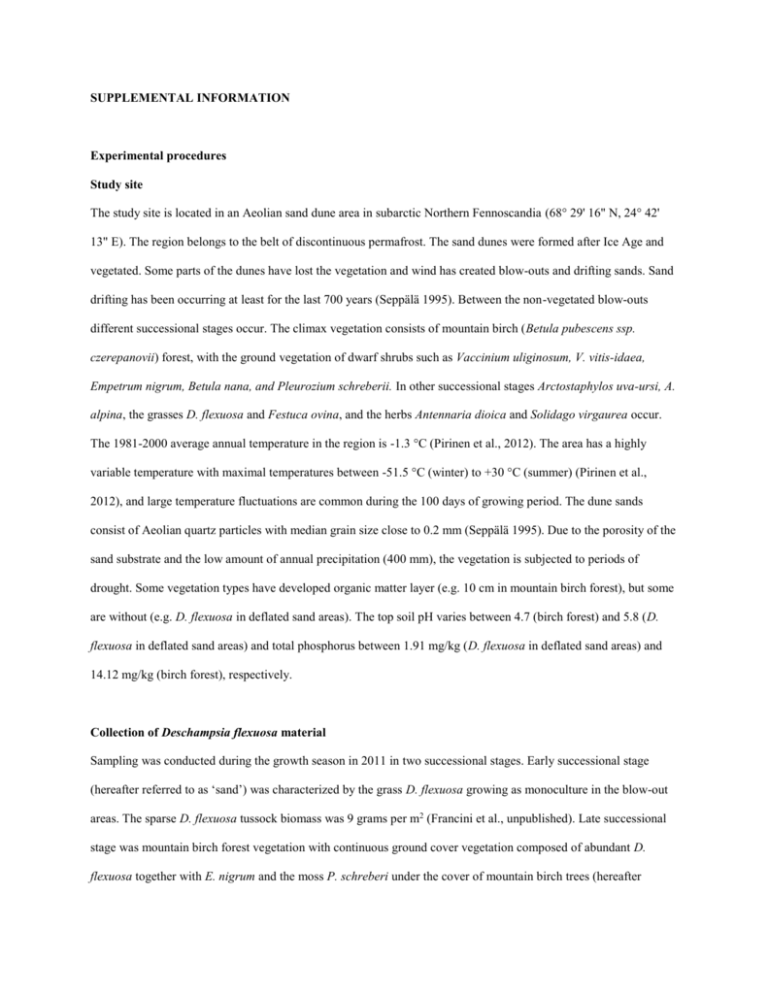
SUPPLEMENTAL INFORMATION Experimental procedures Study site The study site is located in an Aeolian sand dune area in subarctic Northern Fennoscandia (68° 29' 16" N, 24° 42' 13" E). The region belongs to the belt of discontinuous permafrost. The sand dunes were formed after Ice Age and vegetated. Some parts of the dunes have lost the vegetation and wind has created blow-outs and drifting sands. Sand drifting has been occurring at least for the last 700 years (Seppälä 1995). Between the non-vegetated blow-outs different successional stages occur. The climax vegetation consists of mountain birch (Betula pubescens ssp. czerepanovii) forest, with the ground vegetation of dwarf shrubs such as Vaccinium uliginosum, V. vitis-idaea, Empetrum nigrum, Betula nana, and Pleurozium schreberii. In other successional stages Arctostaphylos uva-ursi, A. alpina, the grasses D. flexuosa and Festuca ovina, and the herbs Antennaria dioica and Solidago virgaurea occur. The 1981-2000 average annual temperature in the region is -1.3 °C (Pirinen et al., 2012). The area has a highly variable temperature with maximal temperatures between -51.5 °C (winter) to +30 °C (summer) (Pirinen et al., 2012), and large temperature fluctuations are common during the 100 days of growing period. The dune sands consist of Aeolian quartz particles with median grain size close to 0.2 mm (Seppälä 1995). Due to the porosity of the sand substrate and the low amount of annual precipitation (400 mm), the vegetation is subjected to periods of drought. Some vegetation types have developed organic matter layer (e.g. 10 cm in mountain birch forest), but some are without (e.g. D. flexuosa in deflated sand areas). The top soil pH varies between 4.7 (birch forest) and 5.8 (D. flexuosa in deflated sand areas) and total phosphorus between 1.91 mg/kg (D. flexuosa in deflated sand areas) and 14.12 mg/kg (birch forest), respectively. Collection of Deschampsia flexuosa material Sampling was conducted during the growth season in 2011 in two successional stages. Early successional stage (hereafter referred to as ‘sand’) was characterized by the grass D. flexuosa growing as monoculture in the blow-out areas. The sparse D. flexuosa tussock biomass was 9 grams per m2 (Francini et al., unpublished). Late successional stage was mountain birch forest vegetation with continuous ground cover vegetation composed of abundant D. flexuosa together with E. nigrum and the moss P. schreberi under the cover of mountain birch trees (hereafter ‘forest’). Samples of D. flexuosa were collected from four different blow-out areas between 150 and 2250 meters apart. In each area, we established three plots 20 to 30 meters apart. In each plot, we harvested one plant in both the two successional stages situated within 10 meters from each other. Altogether, the plant material consists of (4x2x3) 24 plants. Deschampsia flexuosa shoots and roots were collected in 24th July 2011. In addition, small seedlings less than 3 cm in height were collected from sand (called ‘field seedlings’ hereafter) at the same time. Deschampsia flexuosa seeds were collected 29th August 2011 from both sand and forest in all the four areas. Endophytic microbe isolation Preweighed plant tissues of root, shoot, seedlings and seeds were surface sterilized by soaking in 70% ethanol for 1 min, 3% sodium hypochlorite for 3 minutes (except seeds, 6 minutes) , 1% sodium thiosulphate for 3 minutes, and washing three times with sterile deionized water for 3 minutes. Surface sterilized seeds were divided in to two portions. One portion was directly used for isolating microbes. Another portion was germinated on a sterile wet filter paper in Petri dishes for 10 days in greenhouse. The germinated seeds were used for microbe isolations (‘experimental seedlings’ hereafter). In order to isolate bacteria, 1g of sterilized tissue (except seed) was homogenized in 3-4 ml of 50 mM potassium phosphate buffer at pH 6.5, and dilution plated as described below. Sterilized seeds were homogenized in 8 ml of BSE buffer (50 mM Tris–HCl [pH7.5], 1% Triton X-100 and 2 mM 2-mercaptoethanol) and centrifuged at 300×g for 5 min (at 15°C). Supernatant was transferred to new tubes and centrifuged at 12 000 ×g for 15 min (at 10°C). Pellets were suspended in 400μl of 50 mM potassium phosphate buffer set to pH 6.5. Serial dilutions were prepared and plated on the R2A media, pH 6.5. Plates were incubated at room temperature for a week whereafter they were moved to +4C and monitored for new colonies. Single colonies of bacteria were transferred to new plates to obtain pure cultures. Pure strains were stored at -80 °C in R2A-glycerol solution. In order to isolate fungi, sterilized tissues were cut into 1 cm pieces and plated directly into malt extract fungal media (Zijlstra et al., 2005). Plates were incubated in room temperature for a month or more. Hyphal tips of the developing fungal colonies were transferred to fresh malt extract agar plates. 16S rRNA and ITS rDNA amplification Single bacterial colonies were transferred to tubes containing 100 μL of sterile deionized water and suspensions were heat lysed at 95 °C for 10 minutes and centrifuged at 13000x g for 5 minutes. Heat lysed suspensions were used as the DNA templates for PCR reactions. The 16S rRNA amplification was performed in a 50-μl reaction mixture including 1-μl DNA template, 0.25 μM of primers 27F (5´-AGAGTTTGATCCTGGCTCAG-3´) and 1492R (5′-GGYTACTTGTTACGACTT-3′), 0.25 μM dNTPs, 1X of Taq buffer, and 1 U Taq DNA polymerase (Fermentas). The PCR amplification was performed as follows: one cycle of 5 minutes at 94 °C, followed by 30 cycles of 30 seconds at 94 °C, 45 seconds at 51 °C, and 1:30 minutes at 72 °C, followed by one cycle of 7 minutes at 72 °C. Fungal genomic DNA was isolated from fresh mycelia scraped from plates using the Qiagen DNA isolation kit according to manufacturer’s protocol and used as template in PCR amplifications. The ITS region was amplified from genomic DNA using the forward primer ITS1 (5’-CTTGGTCATTTAGAGGAAGTAA-3’) and the reverse primer ITS4 (5’- TCCTCCGCTTATTGATATGC-3’). The PCR amplification was performed in a 50-μl reaction mixture including 1-μl DNA template, 0.25 μM of primers, 0.25 μM dNTPs, 1X of Taq buffer, and 1 U Taq DNA polymerase (Fermentas).The PCR program consisted of one initial denaturation step at 95 °C for 5 min followed by 30 cycles at 95 °C for 30 sec, 52 °C for 30 sec, 72 °C for 1 min, with a final extension at 72 °C for 7 min. Sequencing and sequence analysis The PCR products were purified by ethanol/EDTA precipitation and purified PCR products were sequenced with an automated multicapillary DNA sequencer, ABI Prism 3130xl genetic analyzer (Applied Biosystems, USA). Sequencing reactions were carried out using Big Dye Terminator v3.1 Cycle Sequencing kit (Applied Biosystems, Foster City, CA, USA) according to the manufacturer’s instructions. The RDB SEQMATCH (https://rdp.cme.msu.edu/seqmatch/seqmatch_intro.jsp) and NCBI BLAST (http://blast.ncbi.nlm.nih.gov/Blast.cgi?PROGRAM=blastn&BLAST_PROGRAMS=megaBlast&PAGE_TYPE=Bl astSearch) were used to identify the closest phylogenetic relatives. The sequences were aligned, trimmed and analysed with MEGA 5 software (Tamura et al., 2011). The phylogenetic trees were visualized and annotated with iTOL tool at http://itol.embl.de/. These sequence data have been submitted to the GenBank databases under accession number KJ528986-KJ529110 Phosphate solubilization assays All bacterial strains were tested for their ability to solubilize mineral as well as organic forms of phosphate using National Botanical Research Institute’s phosphate growth medium (NBRIPM) supplemented with (g /L) 15 agar, 10 glucose, 5 Ca3(PO4)2, 5 MgCl2• 6H2O, 0.25 MgSO4• 7H2O, 0.2 KCl and 0.1 (NH4)2SO4 (Nautiyal 1999) and phytase screening medium (PSM) supplemented with (g /L) 15 agar, 10 D-glucose, 2 CaCl2, 5 NH4NO3, 0.5 KCl, 0.5 MgSO4 . 7H2O, 0.01 FeSO4 .7H2O, 0.01 MnSO4.H2O, and 3 phytate (phytic acid sodium salt hydrate) (Jorquera et al., 2011) . Seven strains per plate were stabbed in triplicate using inoculation loop. The ability to utilize tricalcium phosphate and phytate on NBRIPM and PSM agar was examined after incubation for 4 days at room temperature. The development of clearing zone around the colonies was used as an indicator of phosphate solubilization by the isolates. Reference Hagerup, O. (1939) Studies on the significance of polyploidy III. Deschampsia and Aira. Hereditas 25:185-192 Jorquera, M. A., Crowley, D. E., Marschner, P., Greiner, R., Fernández, M. T., Romero, D. et al. (2011) Identification of β‐propeller phytase‐encoding genes in culturable Paenibacillus and Bacillus spp. from the rhizosphere of pasture plants on volcanic soils. FEMS Microbiol Ecol 75:163-172 Nautiyal, C. S. (1999) An efficient microbiological growth medium for screening phosphate solubilizing microorganisms. FEMS Microbiol Lett 170:265-270 Pirinen, P.,Simola, H., Aalto, J., Kaukoranta, J. P., Karlsson, P., & Ruuhela, R. (2012) Climatological statistics of Finland 1981–2010. Finnish Meteorological Institute Reports 2012:1 Tamura, K., Peterson, D., Peterson, N., Stecher, G., Nei, M., & Kumar, S. (2011) MEGA5: molecular evolutionary genetics analysis using maximum likelihood, evolutionary distance, and maximum parsimony methods. Mol Biol Evol 28: 2731-2739
